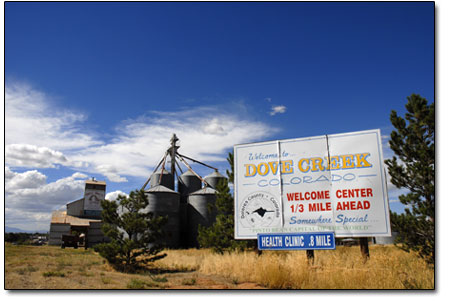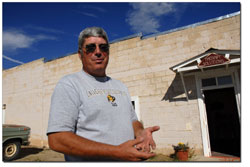|
| ||||
| Re-energizing Dove Creek
by Amy Levek This is going to save us,” says Bill Waschke when asked how the San Juan BioEnergy plant will affect the town of Dove Creek. A third-generation farmer from Dove Creek – which lies in a county where only four farmers are under 40 – Waschke knows the odds. Farming is hard work, often with diminishing returns. Young people don’t want to go into farming, and many leave the area because there’s no work. However, the twist for Dove Creek farmers – and what gives hope to many area residents – is the soon-to-be bioenergy plant, which will rely on sunflowers grown in the region to both fuel the plant and provide raw material for making biodiesel and food-grade sunflower oil. The plant broke ground in early September with all the festivities and fanfare one would expect from a 700-person town that has not seen a new industry in a while. Indeed, nearly half the town showed up to witness the event. However, the significance of the biodiesel plant has implications beyond the stark high plains surrounding Dove Creek, the self-proclaimed “pinto bean capital” of the world. Not only was Gov. Bill on hand to help birth the new facility, but so was U.S. Rep. John Salazar, D-Colo. The project also has gained attention from Colorado State University. “Biodiesel really is a field of dreams,” says Daniel Fernandez, Colorado State University Extension Agent for Dolores County. “There’s an international focus.” Now that some of the hoopla has subsided, Dove Creek’s residents are settling into their part of the plan: growing and harvesting the sunflowers. In 2005, Mayor Jay Allen planted an 80-acre sunflower test plot. The following year another 12 farmers planted sunflower seeds bringing the total to 3,300 acres. By this summer, 41 farmers were growing 10,600 acres of the tough, stately yellow flowers. Waschke, a patient man with a long-term perspective, recounts how biofuels came to Dove Creek. He’s seen a plethora of harsh changes since his childhood, when uranium boomed and then collapsed. “There’s been a steady decline since uranium mining left, followed by a decline in business,” he says. “There were 40 kids in my class in 1977; now most classes don’t even have 20 kids.” In 2004, Jeff Berman, general manager of San Juan BioEnergy, started talking with local farmers. “Jeff he pushed and pushed to make it happen, like a dog with a bone,” said another local farmer, Matt Carhart. “When we started meeting, I believed he could do it, although honestly, the group had a lot of nay-sayers. If you put 10 farmers in a bag and shake it, just see what comes out.” Waschke said the skepticism was strong among old-timers, describing one 71-year-old farmer who complained that “at my age, you don’t want to try new things.” Carhart has seen the resistance to change, too. “For a lot of people, it’s beans and wheat. It’s what their dads did.” But the farmers kept coming. “It was remarkable how many showed up at the first growers meeting in 2004,” says Fernandez. “I was really surprised. The farmers were listening.”
Meanwhile, the Dove Creek community contributed what it could to make the project viable. Land was donated for the plant, creating the Weber Industrial Park just outside of town, and the town will provide initial power to operate the plant. Construction began in earnest this fall, and if all goes well, it will be up and running by spring 2008. Supporters like Fernandez and Carhart see benefits beyond the link to farmers. Businesses and government will benefit, and regional suppliers will also profit. “I’ve been here for 17 years, and this has always been a struggling agricultural community, one of the few on the Western Slope,” says Fernandez. Dove Creek now “has a crop that is tolerant of much of what nature can throw at it.” “There will be spin-offs,” says Carhart, explaining that his son, who is “into big trucks,” bought a semi and may benefit from hauling. Not to mention the by-products of the milling process, which could be used as livestock feed or to generate power for the biofuel plant. “The plant gives me hope,” Carhart says, referring to the possibility that the plant will enable his two sons to return to the area. So far, Berman and his cohorts have raised more than $4.1 million of the $4.6 million needed to build the plant and secure contracts with the farmers. Fernandez, an extension agent, also played a key role. He first heard of biofuel from a friend who went to a meeting in Durango on the project. “My response was ‘bio what?’” he laughs. “It’s been a fast learning curve, although I knew if we had a crop that would grow, it may work.” That’s where sunflowers come in. They’re drought-resistant, and it doesn’t cost as much to make the transition, explains Waschke. Last year, beans yielded 75 pounds per acre compared to 800 per acre for sunflowers, “with a lot less input for a much better bottom line.” The project focuses on dryland farming, a method that should be successful with the drought-resistant sunflowers, given decent winter moisture. “2006 was critical because there was so little moisture,” says Fernandez. “That year we had no beans or wheat, yet we harvested sunflowers.” Currently, Dolores County farmers only irrigate about 5 percent of the county’s 158,000 acres of agricultural lands, with the vast majority already using dryland farming. One factor that got farmers’ attention and pushed San Juan BioEnergy towards greater viability was Frito-Lay’s announcement in March that it would switch from transfats to sunflower oil. “(Farmers) can sell to either the food market or to the biodiesel market or to both,” says Fernandez. Another, according to Berman, is that agricultural commodity prices are climbing, especially because of the switch of corn from a food to fuel. “Commodities are now very tied to the energy market,” he explains. “It doesn’t make biodiesel any less viable, but it affects the price of sunflowers. You can see the cost of sunflowers increase.” But in spite of the rosy predictions, sunflowers do have some hurdles to overcome. Wildlife loves them. The Division of Wildlife is looking into deterrents. But as of yet, there is no economical or practical solution. With 400 acres in sunflower production, Carhart lost close to 25 percent of his crop to wildlife. “That’s my profit margin,” he said. “It’s a huge problem … no one ever expected it.” San Juan BioEnergy is also still evolving. Although it began as a cooperative, members found they could not raise enough money for the plant. Thus, SJB became an LLC, with individual owners around the Four Corners. Some of the original partners, like Durango Mountain Resort, have become LLC members as well. “We plan to work with cities, governments and others to sell our products,” said Berman. Another change, signified by the change from “Biodiesel” to “BioEnergy,” is how the plant will use the byproducts, the hulls. Starting with the 2009 harvest, the plant will burn those, rather than natural gas. “That’s what excites me, we’ll be setting an example for others through generating energy, and solving a range of problems,” says Waschke. The energy produced will be less polluting and provide security. “We’re so dependent on foreign fuel, and we’re also dependent on foreign food,” he says. “We used to have a two-year supply of food and now we only have six months’ worth. Most people don’t understand where our food comes from. Our agriculture is going oversees.” Plus, the project will help keep farmers on their land, keep young people from leaving and keep open space from being developed, as has been the outcome as many other formerly rural areas. “If this falls through, our hope as a farming community is gone,” says Waschke. This year’s sunflower harvest will continue into November. As it comes in, farmers throughout the region will be paying attention. Fernandez says it’s a critical time. “Now we’re trying to pick up the traditionalists, who want to see steam coming out of the plant.” •
|



